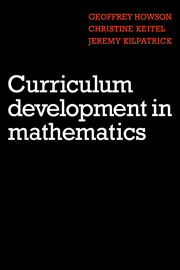Book contents
- Frontmatter
- Contents
- Preface
- 1 Curriculum development: an introduction
- 2 The historical background
- 3 Case studies of curriculum development
- 4 The practice and management of curriculum development
- 5 Curriculum theory and curriculum research
- 6 A retrospective look at curriculum projects
- 7 Evaluation within curriculum development
- 8 Lessons for today and tomorrow
- Appendix 1
- Appendix 2
- Bibliography
- Index
5 - Curriculum theory and curriculum research
Published online by Cambridge University Press: 05 October 2010
- Frontmatter
- Contents
- Preface
- 1 Curriculum development: an introduction
- 2 The historical background
- 3 Case studies of curriculum development
- 4 The practice and management of curriculum development
- 5 Curriculum theory and curriculum research
- 6 A retrospective look at curriculum projects
- 7 Evaluation within curriculum development
- 8 Lessons for today and tomorrow
- Appendix 1
- Appendix 2
- Bibliography
- Index
Summary
The legacy of early curriculum theories
The early decades of this century saw a rapid expansion in the provision of secondary education in the United States. Public high school enrolments, which stood at about 500 000 in 1900, roughly doubled in each of the following four decades.
There was a need then to reconsider school curricula which had to that time not differed significantly from European educational tradition. America needed its own, newly-developed pattern.
The result was an autonomous reform movement in pedagogy, based on a pragmatic philosophy, which was to determine the basic reorientation of American curricula. In the field of mathematics education two opposing tendencies emerged: one originated in social practice; the other viewed social practice as the goal of its reformatory intentions.
The most significant educational figure to emerge was John Dewey (1859–1952). Dewey derived his conception of learning from his observations of how everyone learns in his environment, i.e. through action and experience. Learning in schools should, therefore, also be conceived of as ‘learning by doing’ and ‘learning by experience’. Dewey rejected the division of content into separate school subjects, since this was alien both to the child and to reality. Instead he proposed project teaching based on real objects.
- Type
- Chapter
- Information
- Curriculum Development in Mathematics , pp. 84 - 130Publisher: Cambridge University PressPrint publication year: 1981



